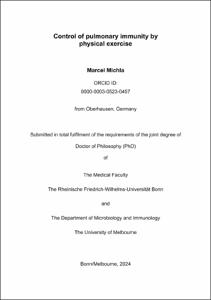Control of pulmonary immunity by physical exercise
Control of pulmonary immunity by physical exercise
| dc.contributor.advisor | Wilhelm, Christoph | |
| dc.contributor.author | Michla, Marcel | |
| dc.date.accessioned | 2024-03-06T13:08:50Z | |
| dc.date.issued | 06.03.2024 | |
| dc.identifier.uri | https://hdl.handle.net/20.500.11811/11399 | |
| dc.description.abstract | Sedentary lifestyles combined with high caloric nutrition are widely known to severely contribute to the rise of metabolic diseases like diabetes, atherosclerosis, or obesity in recent years. While endurance training has been shown to induce the secretion of adipokines, and so-called myokines (muscle-derived cytokines), the impact of physical exercise on the host immune response in the context of bacterial or viral infections remains largely unknown. Here, we aimed to investigate the impact of voluntary wheel running (VWR), mimicking an active lifestyle, on the pulmonary immune system and to which extent a lack of exercise might affect the severity of pneumonia induced by bacterial L. longbeachae or viral influenza A virus (IAV) infection.
We observed that VWR enhanced stamina to exercise and reduced visceral adipose tissue. Moreover, VWR induced the expression of myokines and lipolysis-associated genes and decreased the number of circulating monocytes. Notably, neither acute nor long-term (2 and 8 weeks, respectively) physical exercise significantly affected the abundance or metabolism of pulmonary immune cells in healthy mice. However, upon infection with L. longbeachae, acute physical training reduced pathogen burden, dampened anorexia-induced weight loss, and decreased the recruitment of neutrophils and monocytes to the airways. Additionally, pro-inflammatory cytokines associated with bacterial clearance, including IFN-γ & TNFα increased in the lungs of exercised mice. Notably, VWR enhanced the potential to produce TNFa in both alveolar macrophages and infiltrating monocytes early and late in infection with L. longbeachae. Furthermore, in running mice we found increased mitochondrial and glucose dependency in myeloid cells, crucial for the inhibition of pathogen replication. Our results also show that CD4+ T cells from trained animals display reduced IFN-γ production, suggesting that exercise may predominantly boost the innate immune response. In contrast, during IAV infection, we observed significantly decreased numbers of activated type 1 helper T (Th1) cells in running mice, critical for viral clearance. However, the frequency of tetramer CD4+ and CD8+ T cells was increased, indicating higher antigen specificity of the immune response. Additionally, we found higher viral RNA content in lung tissue from exercising mice, and elevated production of pro-inflammatory cytokines including type I interferons. Moreover, we found higher expression of interferon-signalling genes in the pulmonary tissue of exercising mice. VWR increased the gene expression of Ifng in CD44+ CD4+ T cells in running mice, suggesting an enhanced capacity of CD4+ T cells to produce IFN-γ. Notably, VWR increased the expression of tissue-residency markers on CD8+ T cells. Taken together, our results suggest that VWR might have opposing effects on pulmonary immunity during infection. Hence, we conclude that acute physical exercise might enhance protection against bacterial invasion (L. longbeachae) by specifically boosting the innate immune response. In contrast, VWR reduces Th1-mediated anti-viral responses and increases the pulmonary viral RNA content, suggesting that physical exercise might enhance the susceptibility to IAV infection. However, by boosting the adaptive IFN-γ-mediated anti-viral response, antigen-specificity, and increasing tissue residency, exercise may enhance the defence against secondary viral infections. | en |
| dc.language.iso | eng | |
| dc.rights | In Copyright | |
| dc.rights.uri | http://rightsstatements.org/vocab/InC/1.0/ | |
| dc.subject.ddc | 500 Naturwissenschaften | |
| dc.subject.ddc | 540 Chemie | |
| dc.subject.ddc | 615 Pharmakologie, Therapeutik | |
| dc.title | Control of pulmonary immunity by physical exercise | |
| dc.type | Dissertation oder Habilitation | |
| dc.publisher.name | Universitäts- und Landesbibliothek Bonn | |
| dc.publisher.location | Bonn | |
| dc.rights.accessRights | embargoedAccess | |
| dc.date.embargoEndDate | 15.03.2026 | |
| dc.identifier.urn | https://nbn-resolving.org/urn:nbn:de:hbz:5-74989 | |
| dc.relation.doi | https://doi.org/10.1016/j.immuni.2020.03.003 | |
| dc.relation.doi | https://doi.org/10.1038/s41586-022-05128-8 | |
| ulbbn.pubtype | Erstveröffentlichung | |
| ulbbnediss.affiliation.name | Rheinische Friedrich-Wilhelms-Universität Bonn | |
| ulbbnediss.affiliation.location | Bonn | |
| ulbbnediss.affiliation.otherLocation1 | Melbourne | |
| ulbbnediss.affiliation.otherName1 | University of Melbourne | |
| ulbbnediss.thesis.level | Dissertation | |
| ulbbnediss.dissID | 7498 | |
| ulbbnediss.date.accepted | 25.01.2024 | |
| ulbbnediss.institute | Medizinische Fakultät / Institute : Institut für Klinische Chemie und Klinische Pharmakologie | |
| ulbbnediss.fakultaet | Medizinische Fakultät | |
| dc.contributor.coReferee | Mackay, Laura | |
| ulbbnediss.contributor.orcid | https://orcid.org/0000-0003-0523-0457 |
Files in this item

This document has got an embargo.
This item appears in the following Collection(s)
-
E-Dissertationen (1590)



